Coin Values Moving with Precious Metals: Up-Dated 12/1/2025: Gold $4236 | Silver $56.79
1919 Penny Value
Appraising a coin involves judging a few key areas. 1919 penny value is determined by three main factors: Date | Mint Mark | Condition
Individually these factors are inspected closely for accuracy and listed separately in value charts. A step by step approach first identifies date and mintmark followed by judging and grading condition.
A review of the chart highlights the importance of completing the steps when determining how much old pennies are worth.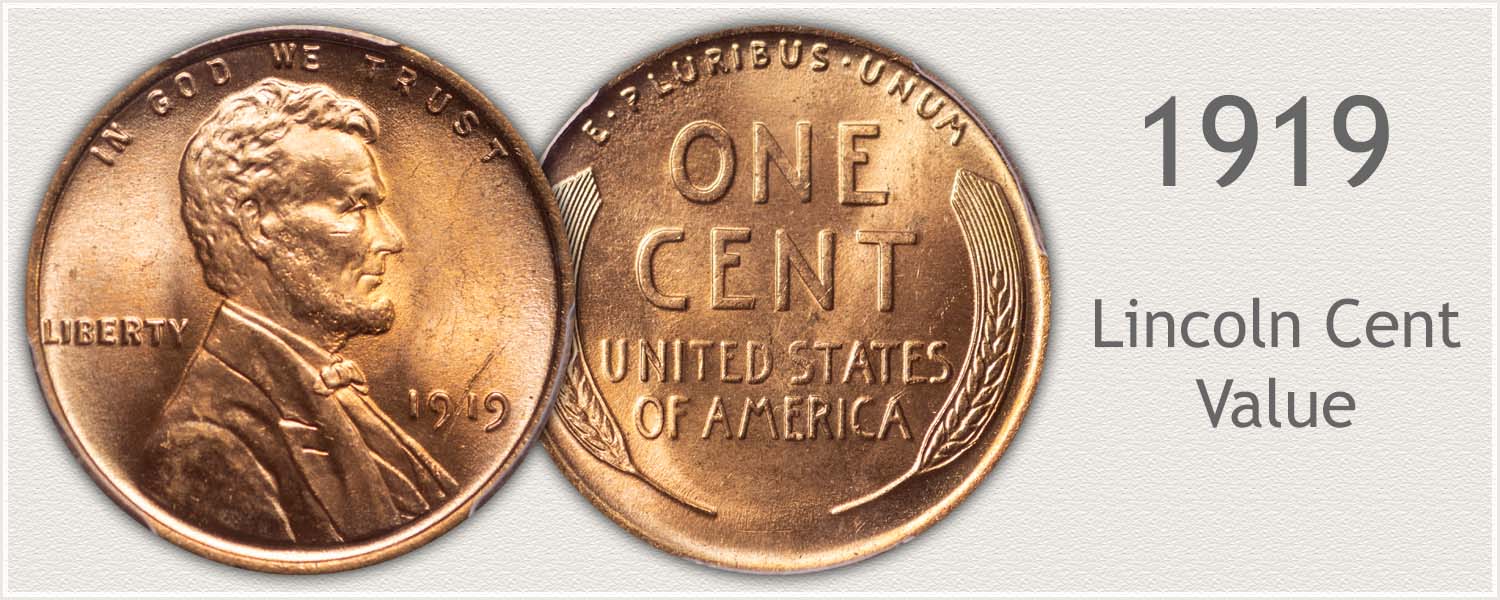
Steps Leading to Value:
- Step 1: Date and Mintmark Variety – Identify each date and its mintmark variety.
- Step 2: Grading Condition – Judge condition to determine grade.
- Step 3: Special Qualities – Certain elements either enhance or detract from value. A review of the chart highlights the importance of completing the steps when determining how much old pennies are worth.
| 1919 Lincoln Penny Value | ||||
|---|---|---|---|---|
| Condition of Coin | ||||
| Date | Good | Fine | Extremely Fine | Uncirculated |
| 1919 Lincoln Penny Value Up-Dated | 2025 | |||
| 1919 | $0.17 | $0.77 | $1.30 | $6 |
| 1919 D | $0.58 | $1.58 | $10.25 | $58 |
| 1919 S | $0.46 | $1.24 | $5.20 | $34 |
Complete the appraisal process verifying date, determine mint mark and judging condition. Date collecting of wheat pennies is a popular theme. Spanning a long run 1909-1958.
Collectors expand collections by adding mintmark varieties. Each coin is listed by mint.
Finally, attention to condition identifies higher quality coins. A visually impressive collection of wheat cents is assembled as higher condition examples are added.
Judge your coin beginning with Mint Marks:
Step 1: | Date and Mintmark Combination
1919 Mintmark Variety Important to Identify
Abundant defines the 1919 year in wheat penny availability. High mintage numbers of the three varieties contributes to existing supply today.
1919 Lincoln Penny
No Mintmark Under Date: Philadelphia Mint Struck the Coin
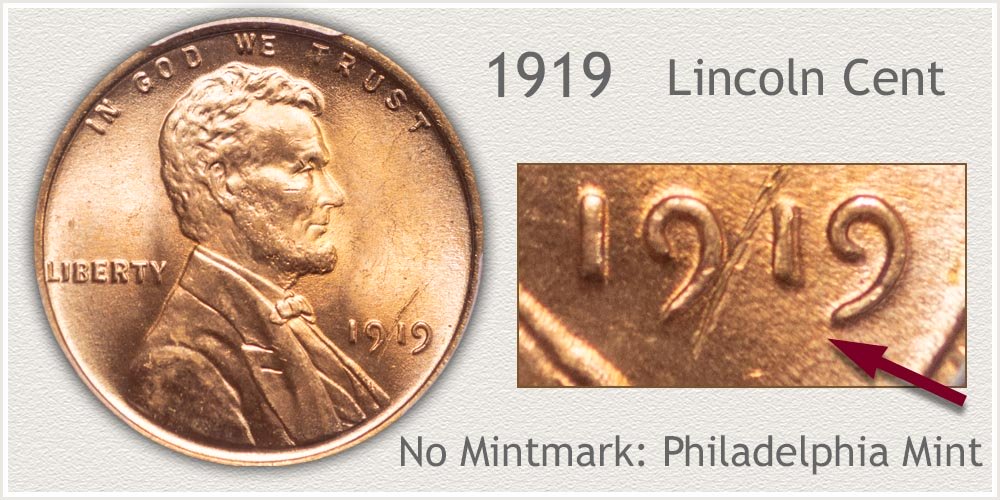
Philadelphia mint struck the largest number of cents in 1919 in the early era (1909-1933) of the Lincoln wheat series. 392,021,000 pieces were coined. This number is not surpassed until 1940. These coins are Abundant on the rarity scale.
To enter a collection and have a premium market value, eye appeal of the coin must stand out. An excellent coin to interest a young collector because of affordability. Without any distracting marks these are an interesting old penny.
1919-D Lincoln Penny
"D" Mintmark Under Date: Denver Mint Struck the Coin
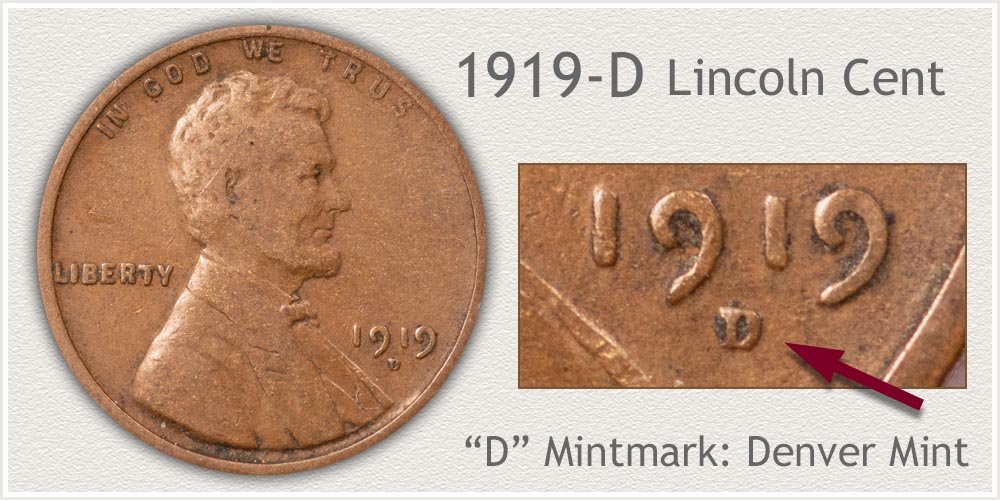
Denver mint variety 1919 pennies are the least encountered of this year's mintage. A nice well detailed coin enjoys a strong value. Inspect the reverse, a well-defined ONE CENT indicates a higher end example. Grading the coin, the next step to the value process is in the following section. Notice the difference in the chart from the Fine to Extremely Fine grade.
1919-S Lincoln Penny
"S" Mintmark Under Date: San Francisco Mint Struck the Coin
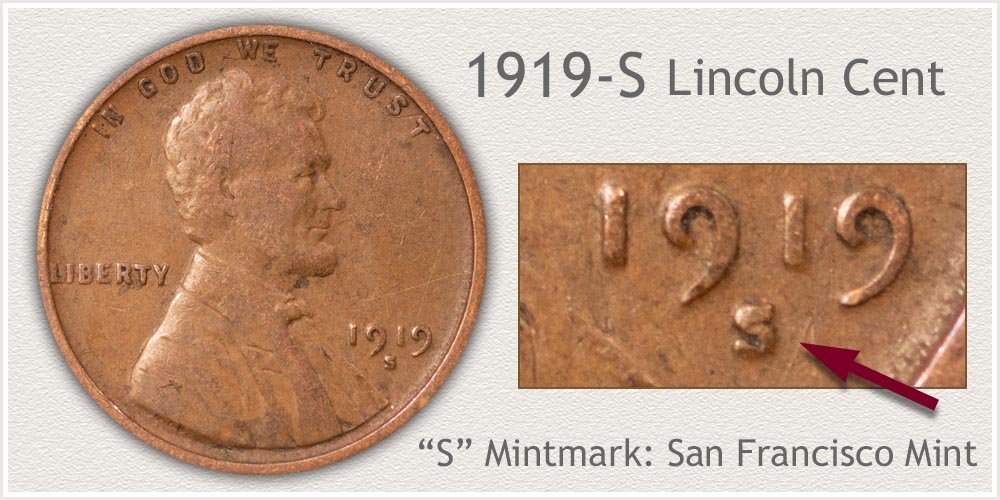
Many of these 1919-S cents are available today. In a condition with just an outline of Lincoln, rarity is at the low level: Abundant. Value of these coins is a matter of the demand for existing supply. Higher demand is found in coins with sharp lettering along the rim, indicating a well detailed coin.
Step 2: | Judge Condition to Identify Grade
1919 Penny Value and Condition
Grade of a collectible coin is one part of the factors used in determining value. Condition is often a large part to value. A coin's state of preservation is judged to arrive at a grade, a defining term used among collectors. Listed on the value chart are Grades ranging from Good to Uncirculated. Following are images used to identify the grade of wheat cents.
As you inspect your coin work over a soft surface. A sheet or two of paper protects the surface of coins from any abrasions.
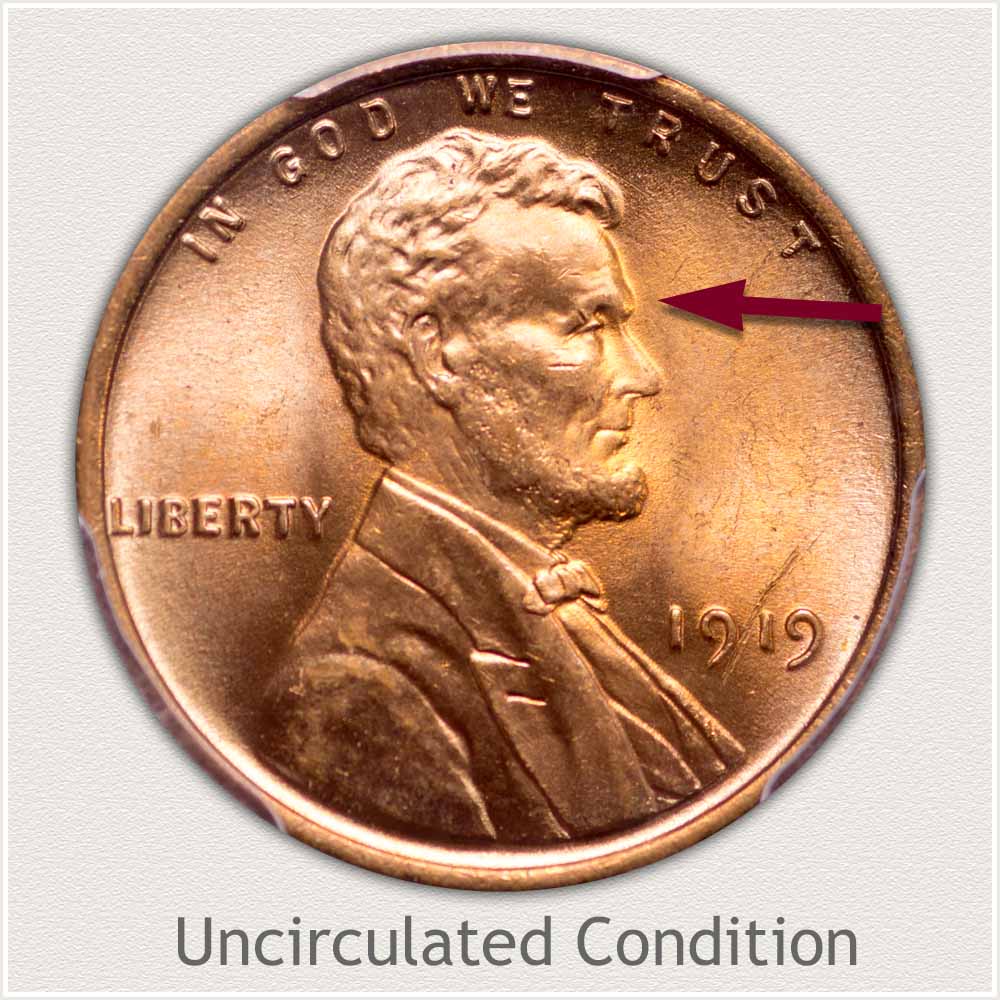
Uncirculated Grade: Vibrant luster shinning from the surfaces indicate an Uncirculated - Mint State grade. No wear to any part of the coin confirms the grade.
Absence of any wear is critical to placing a coin in mint state grade. Highest areas to judge are Lincoln's cheek and jaw. Another small but critical spot prone to first signs of wear is the eye brow. Lack of any smoothing or color change is important. Luster and a texture consistent with the forehead is a sign the coin never circulated.
Strong well-defined details are noted on this 1919 wheat penny. Details of the bow tie are visible and an overall crispness is pleasing.
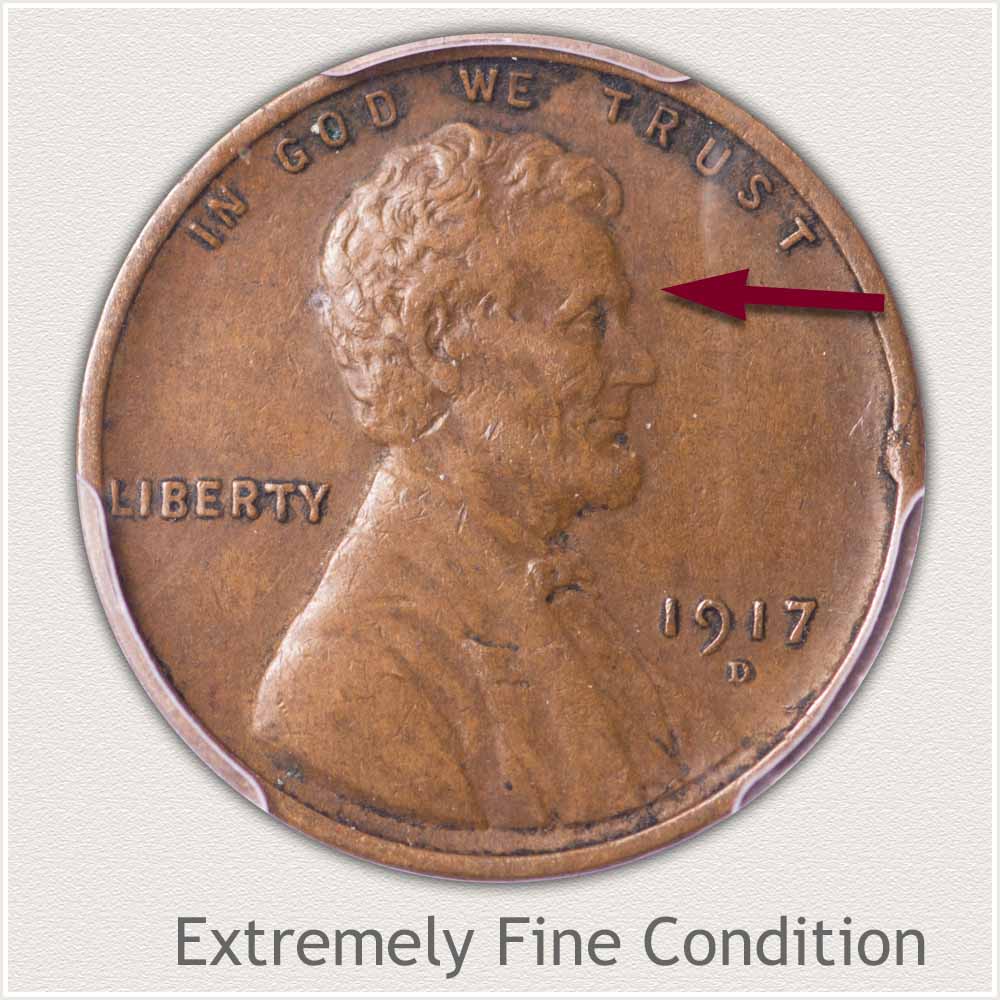
Extremely Fine Grade: As a coin begins to wear small areas of flatness appear on high points. Slight wear defines a coin in Extremely Fine grade.
Lincoln's eye brow is beginning to show signs of smoothing and a small area of flatness is evident. Notice the eye brow remains raised above the forehead and separated from the temple. High and low features are well defined.
Subtle contrasts in color are highlighting details and lend to the eye appeal of this example in Extremely Fine grade. Attractive qualities help strengthen market acceptance.
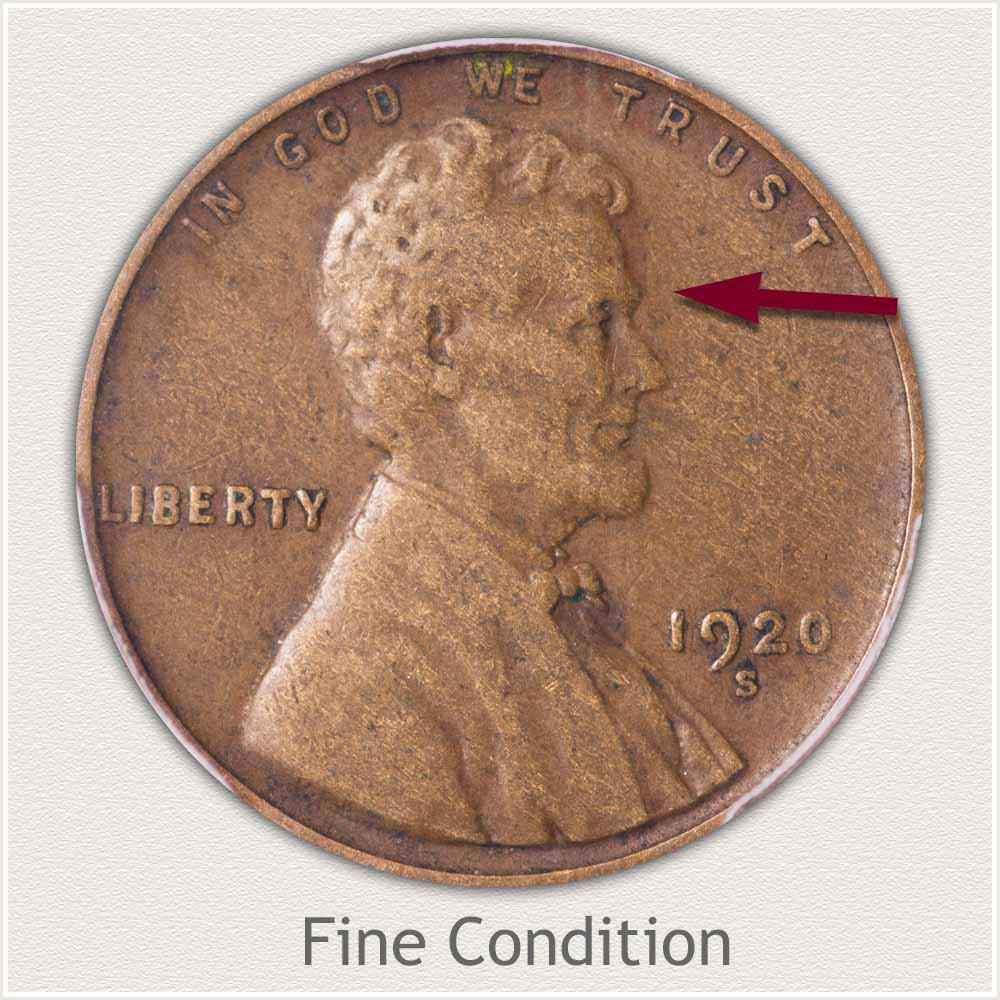
Fine Grade: Moderate wear has reduced small details to flat surfaces. Major details, including waves of hair, remain visible on a coin in Fine grade.
Judge the eye brow, confirm a small but evident separation from the fore head and temple. A distinct contour defining the eye brow remains, placing this example into the Fine grade.
In circulated grades collectors seek coins with qualities that elevate them from others within the grade. Pleasing surfaces are noted on this example. No distracting marks are visible. Fields of the coin are remarkably clear of distractions.
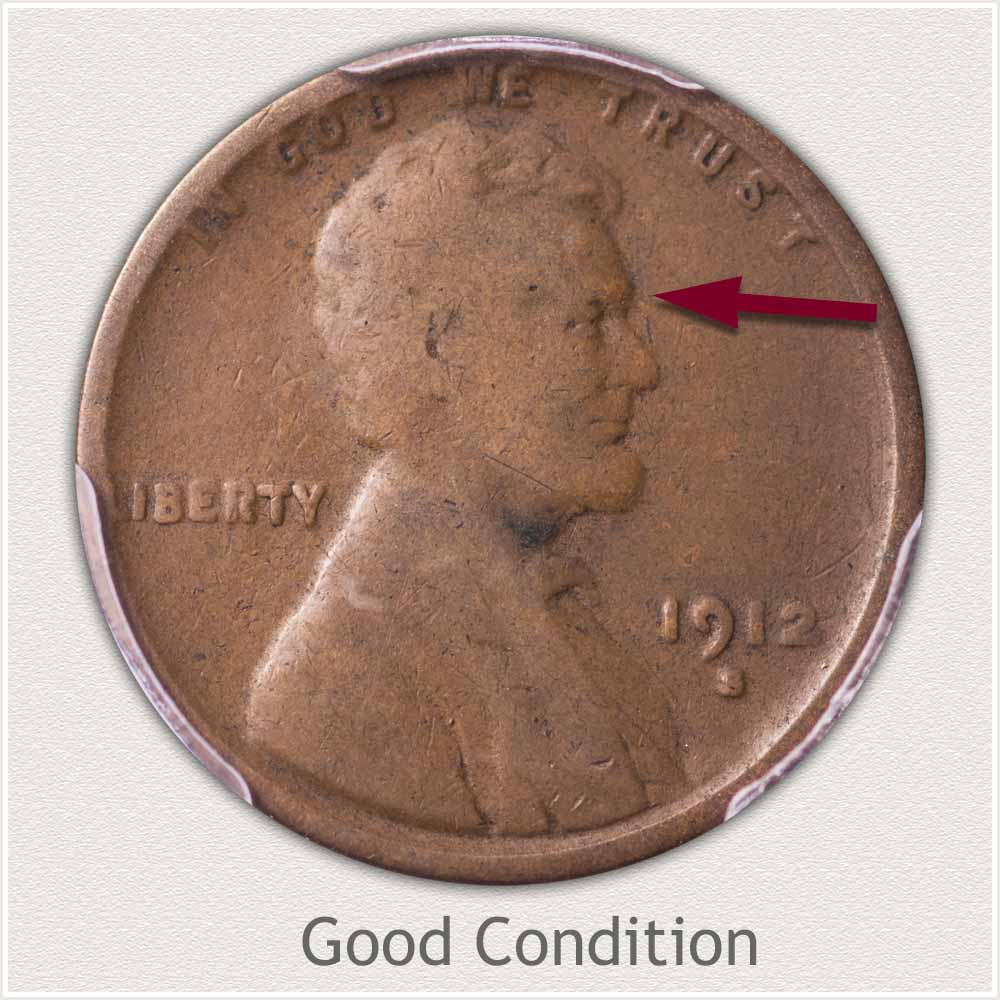
Good Grade: Large connecting areas of flat surfaces defines a wheat cent in the Good grade.
Lincoln's eye brow and its separation from the forehead is now a continuous flat area. Little definition of a temple area is also noted. Fine details and contours above the eye are smooth. A strong outline remains separating the portrait from the field of the coin.
Many early wheat pennies in good condition within the early years of the series (1909 to 1933) are sought by collectors. Scarce dates and mintmarks are affordable and a pleasing example is in demand by collectors. A nice brown toning adds to the appeal of this example.
Video | Grading Lincoln Wheat Pennies
Grading Lincoln Wheat Pennies continues the process of judging condition. Additional video, images, and descriptions are used to define important points to the obverse and reverse.
Step 3: | Special Qualities Enhancing Value
Special Quality: Off-Center Error 1919 Penny
Error coins are occasionally encountered, and Lincoln cent errors are of interest to collectors. These come in many forms, an off-center struck 1919 wheat cent is featured. During the striking phase, collars intended to hold the coin centered were slightly out of line.
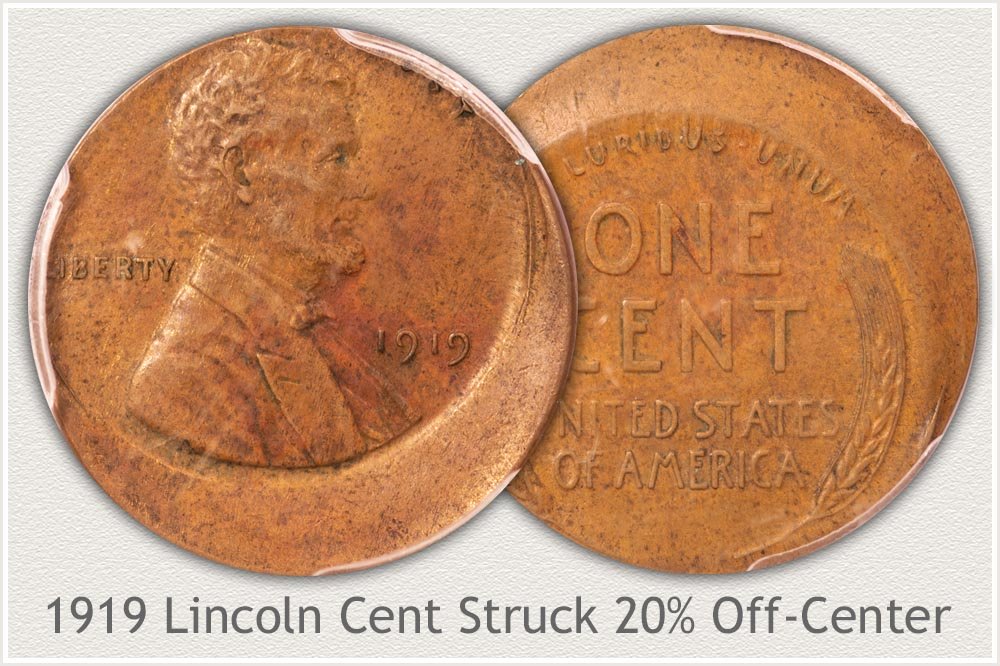
US Mint included in their 1922 mint report a 97.33% "good coin produced" ratio of 1 cent bronze pieces. Any type of error was a rare occurrence. Visual inspection removed the majority leaving few to enter circulation.
This 1919 is a nice example of an off-center strike. The blank planchet was misaligned at the time of striking. Value of these errors are dependent on overall condition of the coin with aesthetics also part of consideration. Amount of off center is in the 15% to 20% range, enough to draw interest. Date is still visible adding to value and no important part of Lincoln is missing.
A collector approaches error coins in terms of desire; value can have a large range from one to another. In the error collecting field, early era Lincoln cents minted 1909 through 1933 are eagerly sought. These are often a specialized collection including as many dates and mints as found.
References
US Mint. 1920 US Mint Annual Report.
https://nnp.wustl.edu/library/publisherdetail/51
Federal Trade Commission. Investing in Collectible Coins. https://www.consumer.ftc.gov/articles/0136-investing-collectible-coins
US Mint. Coin Term glossary. https://www.usmint.gov/learn/collecting-basics/glossary
US Mint. 1922 US Mint Annual Report.
https://nnp.wustl.edu/library/publisherdetail/51
Coin Values | CoinStudy Articles
Lincoln Wheat cents span the years 1909 through 1958. From the top condition coins collected by advanced collectors to worn examples; to an affordable collection for young collectors, the range of value is extensive. Identify your date, mint and condition and refer to the value chart.
Coin Value Guide | How to Value a Coin Collection
A step by step method combined with the coin value online guide identifies how to value a coin collection. Discover how much your box of old coins is worth.
★ Coin Values Discovery finds 1919 Penny Value and...
US coin value charts covering cents to gold. Identify your coins using the image links. Date | Mintmarks | Condition are described and imaged with each series. Small details necessary to accurately value are described.